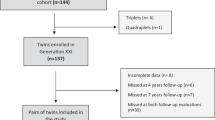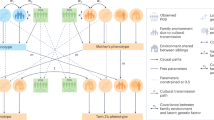Abstract
OBJECTIVE: To study environmental factors promoting obesity when genetic factors are identical.
DESIGN: Monozygotic (MZ) twins discordant for overweight were examined during a 3-day stay in an inpatient setting.
SUBJECTS: The subjects were selected from the Finnish Twin Cohort. The study sample consisted of 23 healthy adult MZ twin pairs (14 female, nine male) with a difference of at least 3 kg/m2 in BMI. The mean BMI was 29.5 kg/m2 for the overweight twins and 22.9 kg/m2 for their lean co-twins.
MEASUREMENTS: Interviews and standardized questionnaires were used to obtain information about energy and nutrient intake, eating behaviour, physical activity history, smoking and other background factors.
RESULTS: The overweight co-twins had higher disinhibition scores (P=0.007) and hunger scores (P=0.005) in the 3-Factor Eating Questionnaire than their lean co-twins. Among women the mean daily energy intake was higher in the overweight twins than in their lean co-twins (8.8 vs 7.4 MJ; P=0.045). In the twins discordant for smoking the mean BMI was higher in non-smokers than in smokers (BMI 29.7±4.4 kg/m2 vs 23.8±3.1 kg/m2; P=0.031).
CONCLUSIONS: Difficulty in controlling eating in both sexes and high energy intake in women were related to overweight, independent of genetic background. Smoking explained the BMI difference among smoking discordant pairs. It is probable that individual twin pairs had different reasons behind the variation in weight gain resulting in non-significant intrapair differences in single obesity-promoting factors. Difference in living conditions (e.g. family- and work-related factors) may have promoted different living habits, especially eating behaviour, and may have led to different weight gain in identical twins.
This is a preview of subscription content, access via your institution
Access options
Subscribe to this journal
Receive 12 print issues and online access
$259.00 per year
only $21.58 per issue
Buy this article
- Purchase on Springer Link
- Instant access to full article PDF
Prices may be subject to local taxes which are calculated during checkout
Similar content being viewed by others
Author information
Authors and Affiliations
Corresponding author
Rights and permissions
About this article
Cite this article
Hakala, P., Rissanen, A., Koskenvuo, M. et al. Environmental factors in the development of obesity in identical twins. Int J Obes 23, 746–753 (1999). https://doi.org/10.1038/sj.ijo.0800923
Received:
Revised:
Accepted:
Published:
Issue Date:
DOI: https://doi.org/10.1038/sj.ijo.0800923
Keywords
This article is cited by
-
Brain reward responses to food stimuli among female monozygotic twins discordant for BMI
Brain Imaging and Behavior (2018)
-
Longitudinal weight differences, gene expression and blood biomarkers in BMI-discordant identical twins
International Journal of Obesity (2015)
-
The skin function: a factor of anti-metabolic syndrome
Diabetology & Metabolic Syndrome (2012)
-
Inaccuracies in food and physical activity diaries of obese subjects: complementary evidence from doubly labeled water and co-twin assessments
International Journal of Obesity (2010)
-
Weight Change in Monozygotic Twins Treated with Valproate
Obesity Research (2005)



